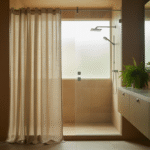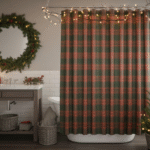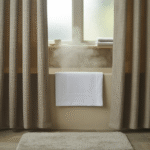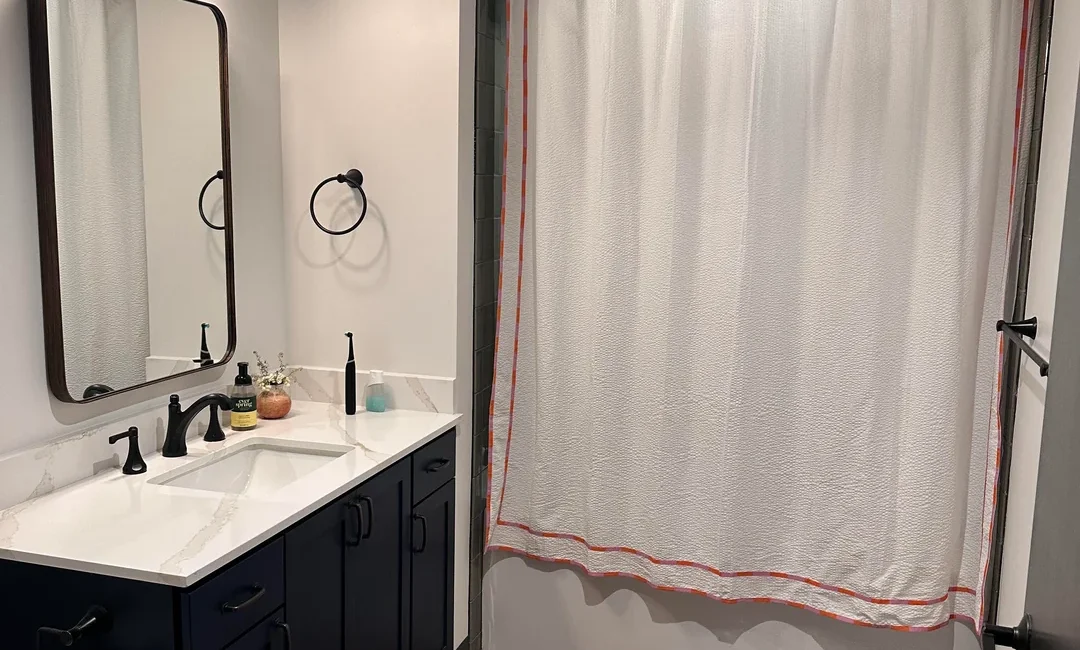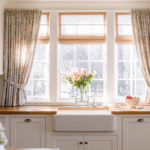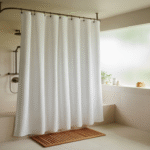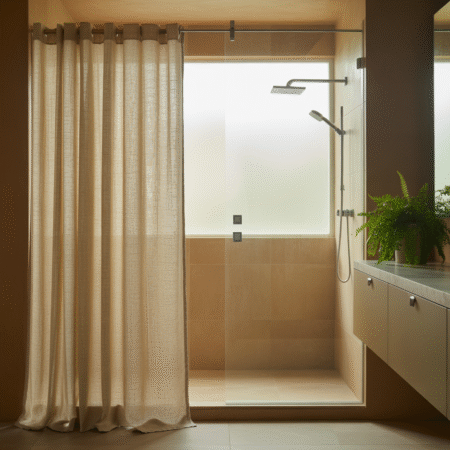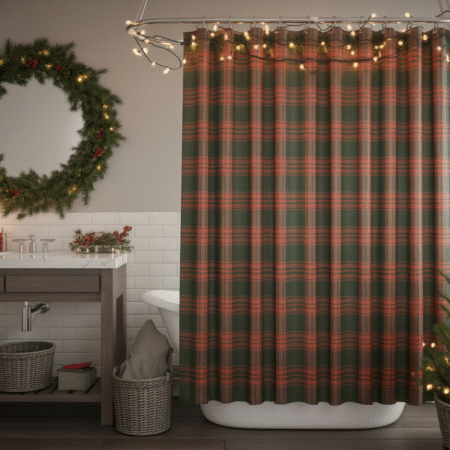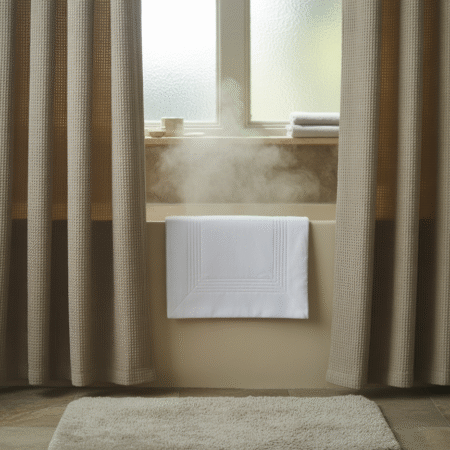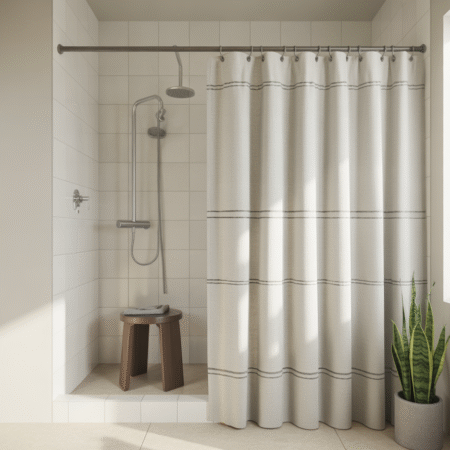You know that feeling when your bathroom looks clean but still feels a little… chilly? Curtains are my favorite quick fix. They soften all the hard tile and metal, add a layer of privacy, and instantly make the room feel welcoming for holiday guests. Think warm wood tones underfoot, a crisp white vanity top, matte black hardware, and a simple fabric panel with a hint of color along the edge—the whole space reads cozy without trying too hard. With the right fabric and a few small upgrades, you can get that “spa at home” mood in an afternoon. In this guide, I’ll share practical bathroom ideas with curtains that work in rentals, small spaces, and family baths alike—plus easy ways to mix color, texture, and hardware so everything feels calm, polished, and ready for the season.
Cozy Café Curtains for Privacy & Soft Light
There’s something instantly welcoming about cream café curtains skimming the center of a tall window. The fabric feels soft and airy, but the coverage keeps morning routines private without darkening the room. A slim, dark rod gives a crisp line that plays nicely with polished fixtures and classic trim.
How to size them right
- Mount height: Hang the rod just above mid-window so the lower half is covered and the upper panes stay bright. If your sill is high, split the window roughly 60/40 (covered/open) to keep natural light.
- Panel width: Aim for 1.5–2× the window width for gentle fullness. If your window is 36″, target 54–72″ total across both panels.
- Drop length: Stop the hem ½–1″ above the sill so splashes don’t wick into the fabric.
Fabric that glows, not glares
- Choose cotton or linen blends in soft neutrals—ivory, oat, or warm white—so the light diffuses beautifully.
- If you face a neighbor, add a thin privacy lining; it preserves the glow while blocking silhouettes.
Hardware that holds up
- Use a tension or slim metal rod with clip rings for easy laundering.
- In high-humidity spaces, pick powder-coated or stainless hardware to avoid rust spots.
Extra privacy without bulk
- If you need more coverage at night, pair café curtains with a frosted film on the bottom panes. It’s renter-friendly and keeps the overall look light.
Quick styling tips
- Keep the pleats soft; a light steam pass makes them fall neatly.
- Echo the curtain color in a bath mat or hand towels to tie the window to the rest of your bathroom.
Floor-to-Ceiling Linen Panels to Soften Hard Surfaces
Full-height panels instantly make a bathroom feel taller and calmer. I love how creamy linen drops from a ceiling-mounted rod, framing the tub like a little spa alcove. Soft gathers, simple pleats, and warm metal hardware keep everything elegant without stealing focus from neutral tile.
How to place the rod for a ‘taller’ room
- Mount at ceiling height (or as high as possible) to elongate the walls.
- For a standard 8-ft ceiling, choose 95–96″ panels so they just kiss the floor.
- If you prefer a relaxed look, allow ½–1″ of break; skip heavy puddling in bathrooms so hems don’t wick moisture.
Fabric + lining that behave in humidity
- Go for linen or linen-blend with a quick-dry cotton or poly lining. It hangs beautifully and resists cling.
- Add a separate waterproof liner behind shower-facing panels if they’ll ever be drawn during a bath.
Tiebacks and details that feel luxe
- Textured tiebacks (braided jute, tassel, or simple cotton bands) create a gentle hourglass shape and keep fabric clear of splashes.
- Repeat warm brass/gold from the rod in small accents—drawer knobs, a petite framed print, or a vessel on a woven stool—to pull the palette together.
Keep water where it belongs
- Use extra-wide panels (72–84″ total per side) so curtains close with overlap.
- Weighted hems or discreet clip-on drapery weights help the fabric hang straight and resist billowing.
Daily care that takes 60 seconds
- After steamy showers, fan panels open to dry.
- A quick hand steamer pass once a week keeps pleats crisp and mildew at bay.
Why it works for warmth
- Tall linen panels absorb echo, soften tile, and add visual warmth next to light stone and geometric floors—perfect for holiday gatherings when you want the space to feel welcoming.
Patterned Shower Curtain as a Feature Wall
If your bathroom leans simple, a bold shower curtain can act like art. Here, wide, painterly swirls in terracotta, mustard, cobalt, emerald, and soft pink turn the tub area into a happy focal point. The white ground keeps things bright, while the curved shapes feel playful against clean tile and a classic tub.
Make color the anchor
- Pull two colors from the curtain—say mustard + emerald—and echo them in small doses (hand towels, a soap dish, a bath mat).
- Keep walls and larger surfaces quiet (white, cream, pale gray) so the pattern reads intentional, not chaotic.
Sizing and drape for impact
- Choose an extra-long curtain (72″ × 84″) if your rod is higher; it looks more custom and prevents the hem from floating.
- Fullness matters: a standard 72″ width works for most tubs, but if yours is extra wide, double up for 1.5–2× fullness.
Practical pairings
- Use a weighted, mildew-resistant liner behind statement curtains so the outer fabric doesn’t cling during steamy showers.
- Opt for rust-proof rings and a sturdy rod; weight from heavier fabrics and double layers adds up.
Style tips that keep it cohesive
- A textured bath mat in one of the accent colors grounds the look.
- If you have open shelving, corral toiletries in neutral canisters so the curtain remains the star.
- Add a single plant or branch near the window to soften all the geometry.
Why it works for warmth
- Color adds emotional warmth fast. Those sunset tones—terracotta, caramel, pink—feel cheerful in winter and pair beautifully with brass or warm wood accessories.
Thermal Curtains to Keep Things Toasty
When the temperature drops, pairing thermal curtains with a discreet insulating layer makes a small bathroom feel instantly warmer. A clear, honeycomb-textured panel (think bubble-like cells) mounted inside the window frame traps air without blocking light, and a soft fabric curtain in front adds the cozy factor.
Smart winter setup
- Layer 1 (insulation): Use a clip-on or hook-and-loop panel that seals around the frame. Aim for a snug fit with ¼” overlap on all sides to stop drafts.
- Layer 2 (style): Hang a medium-weight curtain—cotton twill, linen blend, or thermal-lined fabric—to hide the panel and soften the look.
- Quick check: Hold your hand around the sash after installation; if you feel air movement, add weatherstripping along the edges.
Materials that warm without bulk
- Choose insulated or interlined curtains; they drape better than stiff blackout-only panels.
- Look for microfiber or flannel interlining for warmth with less weight.
Moisture + maintenance
- Open the fabric panel after steamy showers so condensation doesn’t collect behind it.
- Wipe the clear insert with a microfiber cloth weekly; it takes about 2 minutes and keeps the window bright.
Budget tip
- On older windows, this combo can shave a few dollars off winter bills and makes the room feel 2–3°F cozier—great when you step out of the tub.
Layer Sheers + Blackout for Spa-Level Control
Soft, heather-gray drapery around the tub gives that hotel vibe while a clean white inner panel keeps spray contained. The layered look feels luxe next to glossy white tile and a pale, nubby bath rug—bright for daytime, cocooned at night.
Set up a double-rod the easy way
- Use a curtain rod for the outer drape and a separate shower rod for the waterproof liner. If space is tight, choose a double-rod bracket to stack them neatly.
- Hang the outer fabric higher so it skims the floor; keep the inner liner ½–1″ above the tub to avoid mildew at the hem.
Fabric pairings that work
- Outer: textured gray or silver linen-blend—it hides water spots and adds quiet shimmer.
- Inner: mildew-resistant liner with weighted corners so it stays put when the fan kicks on.
Day–night routine
- Day: Pull the outer drapes open for an airy feel alongside the window blinds; the texture frames natural light without adding glare.
- Night: Close both layers for warmth and privacy. The thicker outer curtain dampens echo and softens tile brightness.
Hardware details for a tidy finish
- Choose rust-proof rings and match finishes to your fixtures (chrome, nickel, or black).
- For a tailored look, use back-tab or pinch-pleat panels on the outside rod.
Quick maintenance
- Toss the liner in the wash monthly with a splash of vinegar; steam the gray panels as needed to keep folds crisp.
Festive Plaids & Checks (Seasonal but Subtle)
A classic tartan shower curtain on a crisp white ground brings instant holiday charm without feeling kitschy. The deep cranberry and forest green stripes read warm and traditional, while thin black lines keep the pattern sharp. Against clean white walls and trim, it looks tailored—especially with simple chrome rings and a neat hem.
How to make plaid feel polished
- Keep the rest of the palette quiet: white or pale gray walls, simple hardware, and one warm metal accent (a small brass detail works beautifully).
- Repeat the colors in two small places only—think a cranberry hand towel and a green glass soap pump—so the look stays elevated, not busy.
- Choose a matte or lightly textured fabric; shiny poly can make bold plaid feel costume-y.
Sizing + hanging tips
- If your tub sits near decorative molding, set the rod so the curtain just clears the trim and falls ½–1″ above the floor.
- Aim for 1.5–2× fullness so the plaid stacks into soft pleats (it photographs better and looks more custom).
Care that keeps lines crisp
- Wash on cold, gentle, then hang to dry so the weave doesn’t twist.
- A quick steam pass keeps the stripes straight and the drape smooth.
Pairing ideas
- Add a white waffle bath mat for texture without competing pattern.
- Swap in a cedar or pine-scented candle and a small sprig in a bud vase for a tiny nod to the season.
Natural Textures: Waffle Weave, Muslin, and Cotton
If you want warmth without heavy color, texture is your best friend. A soft gray waffle-weave curtain brings instant coziness alongside pale marble and warm wood. The grid pattern adds depth yet stays calm, and the matching waffle bath mat makes the whole area feel intentional.
Why waffle works in bathrooms
- The raised weave dries faster than flat cotton, which means fewer musty smells.
- Subtle texture adds visual warmth even in an all-neutral palette.
- Light gray hides tiny water marks better than stark white.
How to style it
- Keep the rod straight and simple (chrome or brushed nickel) so the texture stays the focus.
- Pair with soft brass fixtures or wood cabinetry to bring in gentle warmth.
- Choose a weighted liner to keep the textured outer panel from grabbing your legs.
Care that keeps it fluffy
- Wash on cool, then shake and hang to dry; skip high heat so the waffle cells don’t collapse.
- A quick steamer pass relaxes any tight folds and helps the curtain fall in clean waves.
Quick upgrade
- Swap plastic hooks for rust-proof roller rings—the curtain glides smoother and looks more polished for just a few dollars.
Warm Neutrals That Flatter Tile (Taupe, Cream, Greige)
Warm neutrals are the easiest way to cozy up tile. Here, buttery taupe twin panels hang from a dark bronze rod, skimming the floor just enough to feel tailored. The color plays beautifully with soft beige floor tile and subway-style tub surround, while a braided jute rug adds that natural, holiday-at-home warmth.
Picking the right undertone
- If your tile leans warm (beige, tan, travertine), choose taupe or camel curtains to echo those notes.
- If your tile is cool (gray, marble), go for greige—a mix of gray + beige that bridges the gap without looking cold.
Simple formula for a polished look
- Rod: Oil-rubbed bronze or aged brass warms neutrals instantly.
- Panels: Medium-weight cotton or linen blend so they hang in clean, even waves.
- Length: Hem to ½” above the floor for a custom look that won’t wick moisture.
Texture ties it together
- A natural fiber rug (jute or seagrass) keeps the palette grounded.
- Add a woven basket for towels to repeat the texture and make storage feel styled.
Quick styling tweaks
- Use clip rings for soft pleats and easy wash days.
- Keep accessories minimal—one neutral hand towel and a small soap dish—so the tone-on-tone look stays calm.
Pro tip: If your bathroom lighting is cool, swap to warm white bulbs (2700–3000K); taupe and cream read richer under warmer light.
Upgrade the Hardware: Brass, Aged Bronze, or Matte Black
Swapping the rod and rings is the fastest glow-up for bathroom ideas with curtains. Warm polished brass immediately makes neutrals feel richer. A smooth, substantial rod with a rounded backplate reads custom, and a small ring stop keeps panels from sliding past the bracket—tiny detail, big difference.
Pick the right finish for your palette
- Polished/antique brass: Adds warmth and pairs beautifully with taupe, cream, and wood tones.
- Aged bronze: Cozy, traditional, and forgiving with mixed metals.
- Matte black: Crisp contrast for modern spaces or white tile.
Rod styles that change the vibe
- Inside-mount café rods for narrow windows and alcoves—clean and architectural.
- Slim “hidden” rods disappear so fabric steals the show.
- Ball or deco finials add a little jewelry at the edges without feeling fussy.
Strength + size guidelines
- Choose 1–1.25″ diameter for standard windows; go 1.25–1.5″ for shower/tub spans so the rod won’t bow.
- Use center support brackets on spans over 72″.
- For tension rods, look for anti-slip end caps and twist until it feels rock solid—no bounce.
Moisture-smart materials
- Prioritize solid brass, stainless steel, or powder-coated aluminum to prevent rust.
- Rings: roller or ball-bearing styles glide smoothly, even with heavy fabric and liners.
Install like a pro
- When mounting into tile, use a carbide or diamond bit and plastic anchors rated for wet areas.
- Set rods ½–1″ above trim and ½” off side walls so rings move freely.
- For double setups, stagger rods by 2–3″ to avoid crowding.
Styling touch
- Match the rod finish to one other detail—a mirror frame, a small knob, or a soap pump—so the metal feels intentional, not random.
Curved Shower Rod + Drapey Curtain to Gain Elbow Room
A ceiling-supported curved track with a full, white curtain gives you a surprising amount of extra shoulder space—perfect next to warm beige tile and a clean, wood-and-metal vanity. The soft arc reads elegant, and the floor-skimming length makes the setup feel hotel-level polished.
Why a curve helps
- Curved rods add roughly 6–8 inches at the widest point, so you’re not brushing against the fabric while showering.
- The arc also keeps water aimed back toward the tub, reducing splash at the ends.
Measure like this
- Measure the inside width of your tub/shower, then select a curved rod the same nominal size (it’s designed to project outward automatically).
- For ceiling tracks, ensure vertical posts land outside the water zone and anchor into a joist or use heavy-duty toggles.
Curtain + liner sizing
- Go extra wide or use two 72″ panels for 1.5–2× fullness so pleats stay even around the curve.
- Hang the outer curtain to kiss the floor; set the liner ½–1″ inside the tub to prevent wicking.
Keep it moving smoothly
- Use roller rings or track glides so the curtain swishes around corners without snagging.
- Add weighted corners or a magnetic hem to stop billowing from the exhaust fan.
Style pointers
- A matte black track contrasts beautifully with warm neutrals and woven baskets.
- Echo the dark finish in a mirror frame or faucet for a cohesive look.
Quick care
- After showering, draw the liner closed and the outer curtain open to dry both layers faster—mildew has fewer places to hide.
Double Shower Curtains for a Boutique-Hotel Look
Two crisp white panels framing the tub feel instantly upscale—especially on a matte black rod with a clean center opening. The symmetry makes a small bath look intentional, and the inner white liner stays practical for splash control. Flanking storage (those black shelves) looks neater when the curtains draw to each side.
How to get the symmetry right
- Use two identical outer panels and hang them so the center rings meet over the tub’s midpoint.
- If your rod has limited glide, add an extra ring per side so pleats stack evenly and the opening looks balanced.
- Keep the liner in a single piece behind them; it disappears when panels are closed but offers full coverage when you shower.
Pro portions for small spaces
- Mount the rod as high as possible to lift the eye—right under the ceiling if you can.
- Choose 84–86″ long panels for standard ceilings so they skim the floor; that length helps the panels look tailored, not skimpy.
Neat & practical details
- Add weighted corners to the liner to prevent billowing.
- Use black roller rings to match the rod; the continuous dark line looks refined and ties in other black accents (shelves, hardware).
- If your tub curves, place a center hook for the liner on its own ring so it closes tightly at the middle without gapping.
Style it like a hotel
- Keep textiles tone-on-tone (white/cream) for a spa vibe, then introduce one texture—like a woven basket—so the space doesn’t feel sterile.
- A battery puck light above the niche or over the tub adds soft evening glow for guests.
Color Pop Curtains: Forest Green, Burgundy, or Navy
Deep color instantly makes a bath feel warm and moody in winter. Here, a forest-green shower curtain with an elegant gold stag motif turns the tub into a statement. The rich green plays beautifully with warm terracotta accent tiles on the half wall, while simple white walls and a slim framed print keep the look sophisticated rather than themed. A curved chrome rod lets the pattern show in a soft arc, and the freestanding tub keeps things airy.
How to pull it off without overpowering
- Let the curtain be the only big pattern; keep towels and mats in solid neutrals (cream, oatmeal, or charcoal).
- Repeat the warm metallic from the motif in one small place—a brass soap pump or gold-framed art—to tie the palette together.
- If you’ve got patterned tile, choose a solid color curtain in forest, burgundy, or navy so visuals don’t compete.
Pairing ideas that feel luxe
- Green + brass reads classic holiday without shouting.
- Navy + matte black hardware leans modern and moody.
- Burgundy + aged bronze feels cozy and old-world.
Sizing + care
- For curved rods, use extra-wide panels or two curtains for smooth, even pleats.
- Wash deep colors on cold and dry low to protect colorfastness; steam lightly to erase folds.
Quick styling tip
- Add a single leafy plant (like the one by the tub) to echo the nature motif and bring life into a neutral corner.
Vertical or Pinstripes to Make a Small Bath Feel Taller
Slim vertical blue-and-white stripes are magic in tight bathrooms—they draw the eye up, making ceilings feel higher and tubs more sculptural. The look is clean and upbeat, and it pairs nicely with warm brass hardware and light wood floors for a cozy, coastal-leaning vibe.
Get the stripe scale right
- In a compact bath, choose ½”–1″ stripes so they read tidy, not dizzying.
- For more drama, widen to 1.5″–2″, but keep walls neutral so the pattern stays calm.
Hanging tips so lines stay straight
- Level the rod carefully; even a ¼” tilt shows with stripes.
- Use an extra ring at each corner to prevent the edges from bowing.
- Steam from top to bottom, guiding pleats to align the verticals.
Color combinations that warm the space
- Pale blue + brass = soft and inviting.
- Charcoal stripe + black hardware = crisp and modern.
- Taupe stripe + bronze = earthy and cozy.
Mixing with existing finishes
- If you have a clawfoot tub or vintage fixtures, the stripe keeps things fresh rather than fussy.
- Add a solid bath mat in cream or oat so patterns don’t compete underfoot.
Care tip
- Wash on cold and hang to dry; a quick steam brings the stripes back to razor straight.
ChatGPT said:
Pattern Mixing That Works (Florals + Geometrics)
Pattern mixing can feel tricky, but there’s an easy formula: one organic + one geometric. See how the soft botanical shower curtain—with teal, coral, and lilac blooms—pairs with a gold-and-cream striped bath mat? The floral delivers movement and color; the simple stripes ground it so the space feels playful, not busy. A pale backdrop (white walls, classic tub) keeps the combo airy.
Your mix-and-match checklist
- Choose a boss pattern (the floral) and a backup (the stripe). Let the boss cover the largest surface—usually the curtain.
- Keep a shared color thread—here it’s warm yellow/gold carrying from the mat to the flower centers.
- Balance scale: if the floral has medium motifs, pick a narrow stripe so they don’t compete.
- Limit yourself to two patterns max in small baths. Add texture (ribbed towels, woven basket) instead of a third print.
Easy ways to repeat the story
- Bring one color from the curtain into a hand towel or soap dish.
- Add a simple framed print with a thin line drawing—geometric enough to echo the mat without stealing attention.
Pro tip: If your curtain is multicolored, keep hardware and storage neutral (chrome rod, white shelves) so the patterns stay front and center.
ChatGPT said:
Renter-Friendly: No-Drill Tension Rod Café Curtains
You don’t need a drill to get privacy and softness. Tension rods in black, brass, bronze, or white pop into place in seconds and hold lightweight café curtains like a champ. They’re perfect for inside a window frame or across a small nook, and they come with rubber end caps that protect paint and tile.
How to get a snug fit
- Measure the inside span and choose a rod that extends 1–2″ beyond that length.
- Twist until you feel firm resistance; the rod shouldn’t bounce when you tug the center.
- For tile frames, wipe edges dry first so the caps grip well.
Best fabrics for tension rods
- Stick to lightweight cotton, muslin, or linen blends so the rod doesn’t sag.
- Clip rings make laundry day easy—pop panels off and toss them in the wash.
Holiday-ready swap
- Add a removable trim—pom-poms, velvet ribbon, or a thin plaid band—along the hem with fabric tape. It’s festive now and peels off later.
Quick troubleshooting
- If it slips, add clear command hooks just under each end as a hidden safety.
- For odd widths, overlap two small panels in the center; the fullness looks intentional.
Why renters love it
- Zero holes, five-minute install, and it instantly adds warmth to a plain window or open shelf.
Small Bath? Use Curtains to “Zone” the Space
In a compact bathroom, a ceiling-mounted panel can carve out mini zones without building walls. Here, a floor-to-ceiling champagne curtain tucks neatly to one side of the vanity, then glides across to separate the tub area when you want privacy or to hide bath toys. The dark herringbone tile in the alcove becomes a moody backdrop, while the soft fabric warms the white walls and keeps the room from feeling echo-y.
Three smart ways to zone
- Vanity nook: Add a slim panel to one side so guests can use the sink while someone showers.
- Storage hideaway: Mount a short rod in front of open shelves; a tidy drape looks cleaner than baskets alone.
- Laundry corner: If you have a stacked washer in the bath, a full-height curtain keeps detergents out of sight.
Install & sizing tips
- Mount the track at the ceiling to save inches in tight rooms and to make the ceiling feel higher.
- Use triple fullness for a rich, hotel-like stack when the panel is open.
- Keep the hem ½” off the floor so it glides cleanly.
Style note
- A neutral, slightly shimmery fabric reflects light and plays nicely with black fixtures or dark tile, adding warmth without visual clutter.
Keep It Fresh: Care, Cleaning, and Mildew Prevention
Moist bathrooms need a simple routine, not a chemistry lab. A quick vinegar wash is my go-to: pour 1 cup of white vinegar into the washer on a normal cycle with your fabric curtain (and even the liner if it’s fabric-friendly). It cuts soap scum, deodorizes, and helps prevent mildew—no harsh smell once it dries.
Weekly habits that actually work
- After every shower: Close the liner fully so water can run off; open the outer curtain so air circulates.
- Turn on the fan for 15–20 minutes; if you don’t have one, crack the door or window.
- Wipe lower hems with a microfiber cloth—this is where droplets linger.
Deep clean, once a month
- Wash fabric curtains on cold, gentle with 1 cup vinegar (skip fabric softener—it traps residue).
- For plastic/PEVA liners, toss them in on cold with two bath towels (the towels scrub the liner), then hang-dry.
- Treat any spots with a 1:1 vinegar + water spray, wait 10 minutes, rinse, and dry.
Choose materials that help you win
- Look for quick-dry fabrics (waffle, linen blends) and mildew-resistant liners.
- Use rust-proof rings and leave ¼–½” of floor clearance so hems don’t wick puddles.
- If your curtain sits near a drafty window, add a thermal liner so condensation isn’t constant.
Ventilation + spacing tricks
- Keep 2–3″ between liner and outer curtain so air moves.
- If you have a niche or tight corner, a small squeegee pass on tile after showers makes a big difference.
Pro tip: A quick hand-steam not only smooths wrinkles—it warms fibers and speeds drying, which keeps mildew away.
Budget Breakdown: Where to Splurge vs. Save
You can make a big impact on a small budget—promise. A bold floral curtain against classic white tile proves you don’t need a full remodel to wake up a space. Here’s how I usually stack the spend.
Splurge here (worth every penny)
- Fabric quality & fullness: A heavier weave or lined panel hangs better and looks custom. Budget $40–$120 for a statement shower curtain or two window panels.
- Hardware that won’t rust: Solid brass, stainless, or quality powder-coated rods and roller rings glide smoothly and last. Expect $35–$100 depending on length.
- Double sets for width/height: If your ceiling is high or you want lush pleats, plan for 1.5–2× fullness—that might mean a second panel.
Save smart here
- Liner: A mildew-resistant PEVA liner with weighted hem runs $10–$20 and works as well as pricey versions.
- Trim & tiebacks: Add seasonal charm with fabric tape, velvet ribbon, or tassel ties—usually under $15.
- Rings & hooks: Rust-proof aluminum or stainless sets are affordable and look nearly identical to designer ones.
Holiday refresh under $100 (pick two or three)
- New statement curtain ($35–$60)
- Roller rings ($10–$15)
- Cozy bath mat in a coordinating color ($20–$35)
- Hand towel pair to echo the curtain ($12–$25)
- Small greenery or candle for warmth ($8–$15)
Pro tips to stretch dollars
- If your tub area is tall, buy a longer curtain and hem with fusible tape—no sewing, polished finish.
- Want a boutique look? Hang two identical curtains and center-open them; the symmetry reads high-end even with budget panels.
- Shop your home: a pretty basket, framed print, or soap dish in a matching hue can finish the color story for free.
Curtain Sizing & Budget Mini-Tool
Recommendations will appear here.
Tip: Aim for hems 1/2″ off the floor; liners should sit inside the tub by 1/2–1″.FAQs — Quick Answers People Actually Ask
Can I use regular curtains as a shower curtain?
Yes—with a waterproof liner behind them. Keep the fabric panel just kissing the floor and the liner ½–1″ inside the tub. Use rust-proof rings.
What fabrics handle humidity best?
Cotton, linen blends, waffle weave, and polyester all behave well. For windows near the shower, add a privacy or thermal lining to manage moisture and drafts.
How long should bathroom curtains be?
For floor-length looks, hem ½” above the floor to avoid wicking. Café curtains should stop ½–1″ above the sill. Liners belong inside the tub.
How do I keep a fabric shower curtain from billowing?
Use a weighted liner or magnetic hem, keep 2–3″ of space between liner and outer curtain, and run the fan during showers.
What’s the right fullness?
I recommend 1.5–2× the opening width. Smaller bathrooms look neat at 1.5×; for a luxe, hotel vibe, go 2×.
Conclusion — Cozy Now, Easy to Refresh Later
If your bath feels a bit chilly, bathroom ideas with curtains are the fastest, friendliest fix. From café panels that glow in the morning to thermal layers that cut drafts, small fabric changes add real comfort. My favorite takeaways: use 1.5–2× fullness, hang rods high, pick warm neutrals or one bold color, and keep care simple with a monthly vinegar wash. You don’t need to redo everything—try one or two ideas this weekend: swap the curtain, add roller rings, or upgrade the rod finish. You’ve got this. A few soft layers, a little color, and your bathroom will feel warm, welcoming, and holiday-ready.

